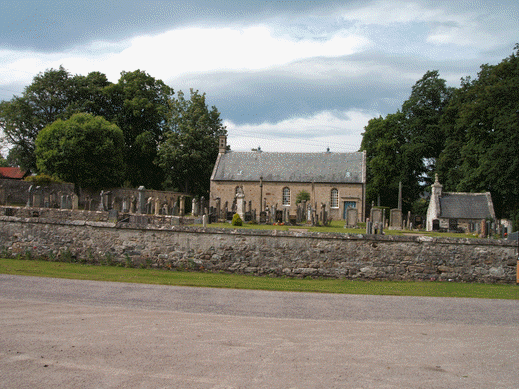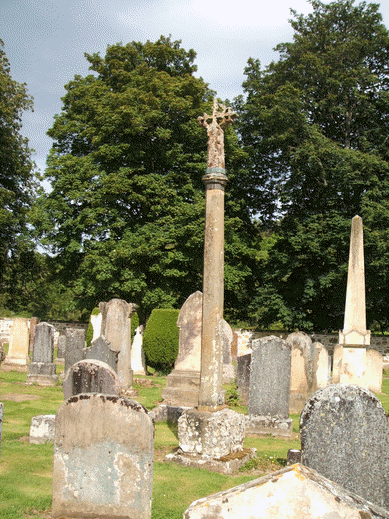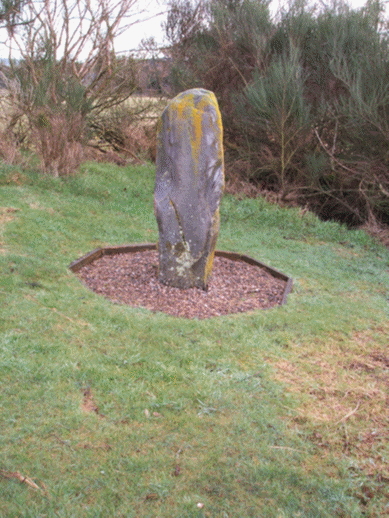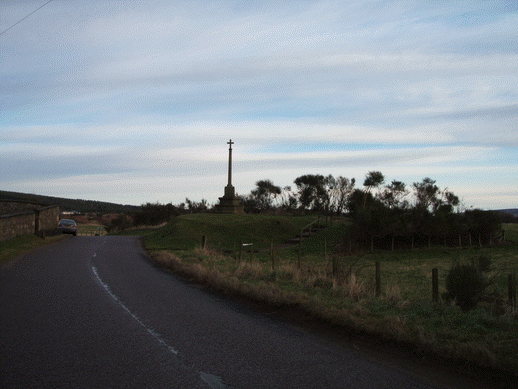Elgin Deanery
Dallas
Dolays Mychel
Parish Church: OS Ref: NGR NJ 122519 H.E.S. No: NJ15SW 4 Dedication: St Michael
Associated Chapels: Kellas {NGR: NJ 170543}; Inverlochty {NGR: NJ 188620}. (but see notes)
This parish is also found called Dolas, Dolas Michael, Dolays Mykel and Doaskyn Mychel.
Dallas was a barony and there has been a church here since at least 1208.1 A parish church was repaired in 1580, but fell into ruin about 1627, and the present building was built in 1793. It is thought that the older churches were situated a little closer to the River Lossie and some foundations have been noted here. Unsurprisingly, there was a St Michael's Well close to the church. Within the churchyard there is a typical medieval market cross where Michael Fair was held. Shaw's description of the old church is less than flattering! Writing c.1882 he says, "A few years ago the church was a very ancient fabric, thatched with heath, and without windows, save two or three narrow slits which yawned to a very disproportioned wideness within, and the effigy of the patron, St Michael, stood weather-beaten in a niche near the top of the eastern gable without, about 4 feet high."2
This is still a tranquil part of the province and a much frequented place for picnics and barbeques at a spot just across the road from the church where the Lossie flows, as ever, like liquid amber.
The boundaries of the present parish were determined in 1657 when Altyre was detached from Dallas whilst Killess (Kellas), to the east, was conjoined to it. Up to that point Killess had been within the parish of Elgin although latterly the lands were apportioned to the Maison Dieu in Elgin.
When the post of Sub-Dean of the cathedral at Elgin was created, at the Diocesan Synod of St Giles, 5 May 1226, the parsonage revenues of Dallas and the altarage revenues of Auldearn (this latter being taken from the Dean's prebend) were assigned as a prebend. Indeed, as late as the 1880s nearly a fifth of the minister's salary at Dallas was still found from the vicarage teinds of Auldearn.3 When the prebend was created Dallas was provided with a vicar perpetual to serve the cure.4


A considerable income was had by the local inhabitants around Dallas by digging peats on the moors to be dried and sold at the markets in Elgin and Forres.
Only about 1km from the church lie the remains of Tor Chastle, an ancient fortification which started life, it would seem, as a motte. The original location of the fortification is at
The complete extent of the lands of Dallas parish is not yet determined. However, in the Thirds of Benefices we read that the corn-lands of the parsonage were 'ridden', c.1561, by James Runsimane (Runsiman) of Innerlochtie,a Robert Andersoune in Barmwcutty (Barmuckity), Andro Garnar, Theophilus Johnnestoun,b along with James Johnnestoun who was a notary.c Afterwards, the following summary was recorded:
| Name | OS Grid Ref. | Yield | Comment |
|---|---|---|---|
| Congtoun | 4 bolls | ||
| Littill Brunquallis | NJ 089525 | 9 bolls | |
| Meikill Ranquallis | NJ 092519 | 9 bolls | |
| The Lewin Aucht | NJ 122514 | 4 bolls | The Oughts |
| Auchness | NJ 116491 | 5 bolls | |
| Kirktown | NJ 123517 | 2 bolls | |
| Ballavrauch with the "out saittis" | NJ 534492 | 5 bolls | Ballachraggan? |
| "Makinrays sett" | 7 firlot | "Mackinlay's sett"? | |
| "Mackawnis sett" | 7 firlot | "MacEwan's sett"? | |
| "Jokkie Tailyouris sett" | 7 firlot | "Jock Taylor's sett" | |
| The Sochowche | NJ 526486 | 6 firlot | Soccach |
| Runynnour | NJ 107527 | 2 bolls | Rhininver? |
| Rothmethe | 1 boll | ||
| Wester Killis | NJ 15_53_ | 12 bolls | Wester Kellas |
| The Mainis and Haltoun of Dolles | NJ 125533 | 14 bolls | Hatton |
| Summa | 5 chalders 2 bolls 3 firlots | ||
| (should be 4c 9b 3f) | |||
| [1 chalder = 16 bolls; 1 boll = 4 firlots] | |||
The parsonage of Dallas, then held by William Patersound, sub-dean of Moray, was, from Lammas (1 August) 1561, sett to James Innes of Drany, Nicholas Tulloche, vicar of Ruthven, and Archibald Dunbar, for a period of three years.
The ancient lineage of this area is well attested to by some very old place-names: Bogmussach; Benshalag; Bednawinny; Eass of Auchness, Hill of the Wangie.
Of course, it is from this simple township that the modern Dallas in the United States gets its name, it being founded by immigrant Scots who traced their origins to this quiet part of Morayshire.
1223x1242 (12 May 1223 x 27 December 1242) Compositio between Andrew, bishop of Moray, and Robert Fyndoc, over the land that Robert used to have on the south side of the River Lossie, which the bishop said belonged to his land of Tullibardine(?), and which Robert said belonged to his land of Kelleys (Kellas), which he held at feuferme of the Maison Dieu of Elgin, and which the bishop accepted in exchange for lands pertaining to the church of Manbeen. Robert quitclaimed to the bishop in perpetuity all the said land on the south of the Lossie, and the land of Kellas besides. For this quitclaim, the bishop, with the counsel and consent of his chapter, has given, granted, and by this pubic writing established to Robert in perpetuity that half davoch of land that Archibald of Inverlochty held of him in the feu of Spynie, by stated bounds, for an annual render of one half mark, half at Pentecost and half at Martinmas, and provisioning three times a year their ploughing (carucam), harrowing (herciam), and carting (carrum), and once in autumn, six good men for the harvest, and performing the forinsec service of the lord king.5
1232 (26 July) Andrew, bishop of Moray, for Donnchad (Duncan), son of Gillemichel McAth; he has given, granted, and by his charter established, all the bishop's land in Dolays Mychel, to hold of the bishop and his successors in feu and heritage, that is, the land which he gave Donnchad in exchange for one davoch of land in Strathardle which is called Petcarene (now thought to be Tullochcurran
1235 (23 February) King Alexander II has given for the support of the poor in the Maison Dieu of Elgin, lands of Manbeen and Kellas, paying suit to the King's Mill of Elgin.8
1237 A compositio (friendly agreement) is formed between Andrew, bishop of Moray, and the Maison Dieu of Elgin and the brothers and sisters of that house, over certain lands which the bishop said belonged to his land of Manbeen, whereby the Maison Dieu will have in perpetuity all the land that was the bishop’s at Manbeen, in pure and perpetual alms, free and quit from all service, exaction, custom and demand pertaining to the bishops of Moray, by the bounds by which the bishop held them, with all its just pertinents. The boundary between Manbeen and Birnie will be the River Lossie as it flows at the time of this writing. Bishop Andrew will have in exchange for this land and for their quitclaim, all the land of Kellas which was the land of the aforesaid Maison Dieu, by its right bounds, and with all its just pertinents, as freely and quietly as Alexander of Douglas and the aforesaid house held it by the donation of King Alexander, saving the feuferme to Robert Findoc and his heirs. They will also have in perpetuity a croft in Elgin which that house had at the time of this agreement, neighbouring the precentor’s house. It was also agreed that Robert Findoc and his heirs will respond in all things to the bishop, saving 5 marks annually which is owed for the land of Kellas.9
1242 The prebend of the Sub-Dean is confirmed as comprising:
- the church of Dolays Mychel saving the bishop's ½ dabhach (of his mensa) and the episcopalibus;10
- the altarage of the church of Eryn (Auldearn) {detached in 1226 from the Dean's prebend}, with the toft and croft there, saving the perpetual deaconry {it would appear that the perpetual vicar serving the cure at this time was in 'deacon's orders};
- all the corn teinds in both the parish (of Dallas) and the chapel of Invernairn.11
before 1279 King William I grants to William de Rypeley (Ripley), Dolasmykel (Dallas), for the service of a quarter of a knight.12
1279 (5 September) Alexander, king of Scots, has given, granted and by this his present charter established to William of Dallas, knight, for his homage and service, the land of Meikle Dallas by the same bounds by which the late W[illiam] his grandfather infefted the late William of Ripley his progenitor, in feu and heritage, with sake and soke, pit and gallows, toll, team and infangthief, and with all other just pertinents, for the service of the quarter part of a knight, saving to the bishop of Moray those 2s. which he is accustomed to receive every year from the said land.13
before 1411 Sir Thomas Cuming of Altyre, some time before 1411, obtained certain lands within the barony (Dallas), and in 1419 received a license from James I. to erect a castle or fortilace at Dallas. Ruins of the stronghold and outworks of Tura Castle, which appear to have been moated, occupy an eminence on the side of the Dorval Burn, about a mile north from the Church.14
Kellas: According to the Ordance Survey Name Book,15 the foundations of a pre-Reformation chapel were still visible as late as 1871, surmounting a small mound, called Chapel Hillock, which was formerly a graveyard. The standing-stone which is on the site was moved from its original position at


As early as 1237, Robert Fyndoc held Kellas in fue from Bishop Andrew of Moray; and in 1443, King Alexander granted it to God, the Blessed Virgin Mary, the Evangelist St John, and to the Maison Dieu in Elgin. After the Reformation, the lands of Killess or Kellas belonged, for a very long time, to the family of Farquharson of Kellas until that family became extinct. The church lands of Easter Kellas were annexed to Dallas parish in 1657 upon the translation of the nearby Altyre lands from Dallas to Rafford parish. Consequently, for the whole of its medieval existence, the chapel of Kellas was not part of Dallas.
Inverlochty: According to Mackinlay,16 there was a chapel of St John Baptist at Inverlochty, "where the Lochty or Black Burn, a rivulet of Dallas parish, joins the Lossie." This would position the chapel at
In the charter to Robert Fyndoc5, Robert claims that the lands in question, which are "on the south side of the River Lossie", are part of his estate of Kellas, and that he held them at feuferme of the Mason Dieu in Elgin. In this same charter "the Church of Munben" (Manbeen) is mentioned which may suggest this is the chapel of St John at Inverlochty. The map shown below reveals that Inverlochty was a sizeable estate and encompassed what are now called the lands of Manbeen.
.jpg)
1208x1215 Symon, parson of Dallas, signs as witness bishop Bricius' Magna Carta by which he established the constitution for the cathedral at Spynie.17
1226 (5 May) Symon, vicar of Dallas signs as witness bishop Andrew's charter which summarizes the decisions of the Synod of St Giles.18
1. Moray Reg., 46. (Simon, the parson of Dolays, was a signatory to Bishop Bricius' Magna Carta, which is dated to 1208x1209.) Return
2. Shaw, L (1882) The History of the Province of Moray, vol.ii, 47. Return
3. Shaw, L (1882) The History of the Province of Moray, vol.ii, 50. Return
4. Moray Reg., 69, 81; Cowan, Parishes, 8, 44. Return
5. Moray Reg., no.27. Dated 12 May 1224 x 17 December 1242. Return
6. Although many scholars believe that Petcarene is now called Tullochcurran, it is possible that they are mistaken and that it actually refers to Pitcarmick
7. Moray Reg., no.79. Dated 7 Kalends Augusti. Return
8. RRS, iii, no.216. Given at Aberdeen. Return
9. Moray Reg., no.39. Return
10. The episcopalibus here means 'those things in this place that normally belonged to the bishop'. Return
11. At this date, what is now the town of Nairn, was called Invernairn. It was a small place which only had a chapel and it lay within the parish of Auldearn. Return
12. RRS, ii, 576, p.479; SRO, RH 6/58. Return
13. RRS, iv, no.124. Given at Stirling. Return
14. Shaw, L (1882) The History of the Province of Moray, vol.ii, 54. Return
15. OS Name Books 1868-1871, Morayshire, volume 07, OS1/12/7/64. Return
16. Mackinlay, J M (1910) Ancient Dedications in Scotland: Scriptural Dedications, Edinburgh, 334. Return
17. Moray Reg., no.46. Return
18. Moray Reg., no.69. Return
a. A James Runseman was "officiar to my Lord bishope of Murray" on 14 December 1551. [The Records of Elgin, vol.i., p.113]
The same James had a charter of legitimation from the Queen, dated at Edinburgh on 5 May 1550, he being the 'bastard' son of David Runsyman, a chaplain of Moray diocese. [The Records of Elgin, vol.i., p.112.] Return
b. A Teophilus Jhonsoun, along with (Sir) James Johnsoun and Fransy (Francis) Johnsoun, "bastardis filiis naturalibus" of Sir Willyem Johnsoun, chaplain, appeared in the Burgh Court of Elgin with letters of legitimation, of date at Edinburgh, 26 August 1550. [The Records of Elgin, vol.i., p.112.]
The term Sir was often used in these times as the mark of a person in one of the grades of Holy Orders. Return
c. James was the second of the three Johnsoun brothers (vide supra). He appears to have been in Holy Orders and to have been a notary. Return
d. William Paterson was sub-dean of the cathedral for a very long time (1529-1562) and may possibly have held some rights in the parsonage even after he resigned into the hands of the Pope (on or before 22 April 1562) following the Reformation. He was escheated on or before 5 March 1577. [Fasti Ecclesiae Scoticanae Medii Aev: ad annum 1638, p.232.] Return
e-mail: admin@cushnieent.com
© 2021 Cushnie Enterprises
